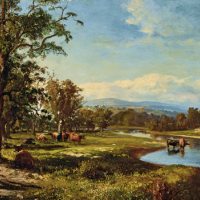45. LOUIS BUVELOT

Louis Buvelot, a Swiss-born migr and artist, significantly enhanced his reputation as an important Australian artist during the 1860s and 1870s. By 1870, the year in which Emu Creek, Landscape near Terrinallum, Victoria c1870 was probably painted, Buvelot was being praised in the highest terms. Acknowledgement of his contribution to the first Victorian Academy of Arts exhibition was noted: To be sure there are no Millais, nor Landseers, nor Holman Hunts, nor Friths; but there is Buvelot, and he represents a great deal.1 By 1870, Buvelot was considered one of Australias pre-eminent landscape painters2 and his majestic Waterpool near Coleraine (Sunset) 1869, another Western District painting, was added to the growing list of Buvelots major paintings in the National Gallery of Victoria Collection.
John Cumming, a wealthy Victorian grazier, commissioned Buvelot to produce a painting of his Terrinallum property and homestead in 1868. The scene included the adjacent Mount Elephant and the Derrinallum district that formed his substantial Western District holdings. Terrinallum was highly regarded for its rich volcanic soil and flat terrain. The property was bought by the Hon. John Cumming in 1856 as a cattle and sheep concern and was subsequently expanded to include the adjacent Mt Fyans property (acquired by his brothers in 1859), as well as Stony Point, Six Mile Creek, and Mount Violet. John Cumming was the quintessential migr made good and he wanted to commemorate this hard-won gain by documenting his familys success and their connection to the land.
Louis Buvelot first visited Victorias Western District in 1867. Pencil sketches and watercolours held in public collections and dated 1868 reveal that he returned to the area the following year.3 On this occasion he was a guest of John Cumming Sr. and his family. Four of the resulting commissioned paintings were sent to Cummings son in 1873, who was studying at Cambridge in England. The father expressed his admiration for the works in a letter to John Jr., adding: I thought the pictures would interest you [too] being of the subjects so well known to you4
This comment underscores the detailed response Buvelot made to the landscape. Emu Creek, Landscape near Terrinallum is the work of an accomplished paysagistes intimiste. It revels in the simple and the commonplace. Terrinallum Homestead, in contrast, is an amalgam of composite images, an attempt to convey a much larger cache of information. Inasmuch, it takes Buvelot the painter out of his comfort zone.
The gift of Buvelots vision is seen in individual details. The dazzlingly bright, emerald, green grass permeates each of the two paintings. Terrinallum Homestead was noted at the time for being too green, too unnatural, looking unlike any grass ever seen in thirsty Victoria.5 However, this fails to account for the excellent rains that had covered the Western District in fresh spring grass and the lakes and overflowing spring-fed dams that Buvelot saw there in 1868. Added to this telling aspect is the robustly and knowledgably rendered gum tree to the left foreground of Emu Creek, Landscape near Terrinallum. It is an expression of joy, a strong anchor that grounds Buvelots commitment to an idiosyncratically Australian terrain.
Louis Buvelot was a painter of his time but like Eugene von Gurard (1811-1901), his pictures did not convey the continuing existence of Aboriginal tribes. Nor did they allude to the darker side of pastoral life that stained the reputation of the Western District the forceful removal of the Djargurd Wurrong people in order to farm the land. The infamous 1839 massacre of 35-40 Aboriginal people in their sleep was led by Frederick Taylor, a manager at Glenormiston station. The 25km Taylors River was renamed Mount Emu Creek by other landowners to express their horror of his actions.6
Despite this, Buvelots gift is to find meaning and significance in the simplest and most amenable of settings. He revels in natures beauty on an almost molecular level. All the commissioned works of Terranillum, including Buvelots sprawling Terranillum Homestead 1869, are in the collections of state and national Australian galleries. Emu Creek, Landscape near Terrinallum, Victoria is rare and desirable, a painting retained by the Cumming family until 1982 which reappears once again at auction.
FOOTNOTES
1. Touchstone, 3 December 1870
2. Gray, J., Louis Buvelot: His life and work, unpublished MA thesis, University of Melbourne, 1977, p.212
3. Terrinallum 1868, Bendigo Art Gallery and National Gallery of Victoria Collections
4. Quoted in Colman, A., Buvelot, the Migrant Artist. Interpreting New Worlds in Brazil and Australia, The La Trobe Journal, no.75, Autumn 2005, p.69
5. Melbourne Daily Telegraph, 1 April 1869, p.2
6. Wilkie, B., Landscapes of the Dead: History and Memory in a distant field of murder, Meanjin Quarterly, Summer 2016
Rodney James
Rodney James is an independent art consultant who specialises in valuations, collection management, exhibitions, research and writing, and strategic planning for art galleries and museums.